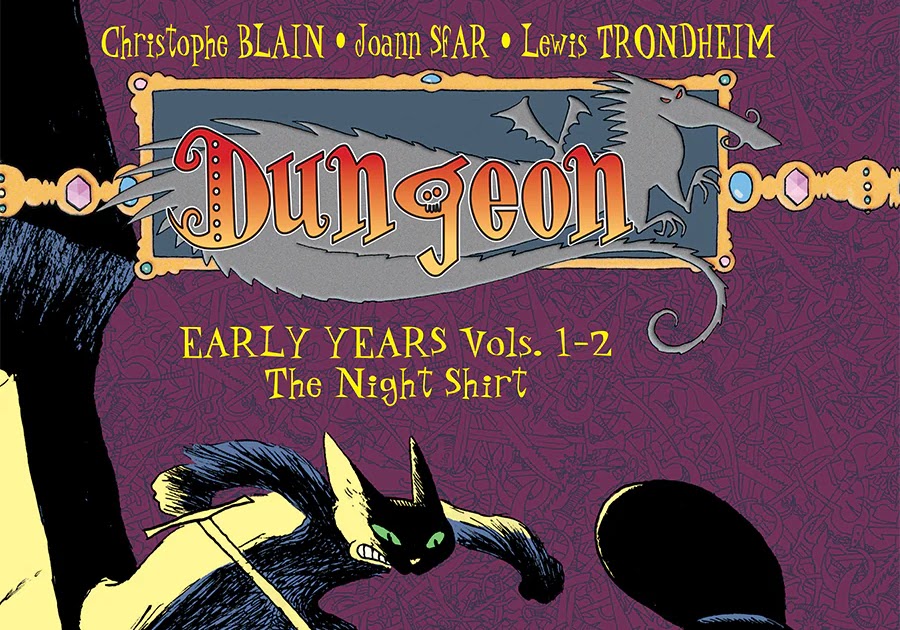
The main title, nicknamed “Zenith,” shows the dungeon at its height and introduces an idiot duck named Herbert trying to get a job in the dungeon. He befriends the Keeper’s top man, a dragon named Marvin, and accidentally acquires a sword that demands he go on a quest. It’s funny but also satisfying as a solid piece of genre fiction. The conceit is that Dungeon would run for a hundred volumes, but Zenith only had 10 volumes.
Trondheim & Sfar didn’t want to do a conventional narrative. They wanted to play with the story in fun ways, asking the question, “Hey, how does it all wind up?” So they zoomed ahead to volume 101, starting a series of stories called “Twilight.” Years later, we see what became of Herbert, Marvin, and many others, and it’s a surprisingly grim story, still leavened by lots of slapstick. If that wasn’t enough, they zoomed back in time to volume -99, called “The Early Years,” which introduces us to the keeper in his youth. (There are also Antipodes + and -, which go way further into the future and past, but those haven’t been translated into English yet.)

NBM had originally published these in small digest format, which hurt the reproduction of the art, which was originally published in France in the oversized album format. NBM finally reprinted them again at the right size and published all of the Early Years stories. The six original French albums have been published in two editions: The Early Years Vol 1-2: The Night Shirt, and The Early Years Vol 3: Without A Sound. Overall, these volumes are a great improvement over the previous editions. There are still some quirks; there are lettering errors in the translation, for example. It’s still exciting to see so many volumes of Dungeon translated into English, though NBM’s recent shift to mostly doing biographies would seem to indicate there won’t be any more forthcoming.

There is a consistent character arc in the series that is reflected by the protagonist of each of the main series. The hero initially is highly naive and idealistic, but they are eventually worn down by their experiences and become corrupted and cynical. This happens to the Keeper, aka Hyacinth de Cavallere, and it happens to Herbert (and it’s shocking when it does). Marvin the Red, the hero of “Twilight,” is certainly naive at the beginning, but as the world literally falls apart, his narrative goes in the opposite direction: from a wannabe hard-boiled killer to a family man.

“The Early Years” focuses on Hyacinth’s journey from pampered son of a warlord to cold-blooded assassin. Both Early Years and Twilight depict an old order crumbling before the eyes of the protagonists, and the stories are that of adaptation and finding a new steady-state. In “The Early Years,” the old world of knights, warlords, and chivalry came to an end, symbolized by the fall of the capital city Antipolis. It’s the seat of all knowledge and law, but it’s being undone by its own corruption, greed, and squalor. The first three volumes (-99, -98, and -97) detail Hyacinth becoming a sort of bumbling vigilante named “The Night Shirt,” who fights for justice in the corrupt city. His undoing is falling in love with a snake-woman assassin named Alexandra.
The narrative then jumps ahead to volumes -84, -83, and -82. Hyacinth is rich and powerful, and secretly the head of the assassin’s guild, but he is in mourning because his lover Alexandra has murdered his sweet wife. His own greed helps settle the city’s destruction, and he’s forced to flee to his family castle. By the end of the last volume, he’s assembled the crew that would make up the foundation of his dungeon, including a five-year-old Marvin the Dragon. Christophe Blain drew the first four volumes, and he was an outstanding choice as someone who has done so many action epics. Working within the Dungeon style, Christophe Gaultier brings a darker, grittier quality to the story than the others, but it’s fitting for how nasty his chapter was. Stephane Oiry’s chapter is brighter and clearer, which was also befitting a more optimistic story. Selecting the right artists for the job showed that Trondheim & Sfar were smart editors in addition to being great artists. “The Early Years” might be my favorite entries in the whole Dungeon saga, as they are satisfying in how they create the character narrative as well as having tons of fun lore-related easter eggs for fans of the rest of the series.


